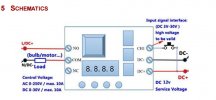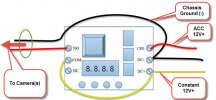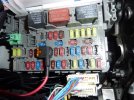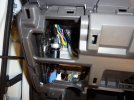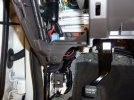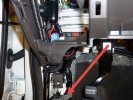erkme73
Well-Known Member
- Joined
- Jun 30, 2013
- Messages
- 675
- Reaction score
- 367
- Country
- United States
- Dash Cam
- a119v3 x 4
Sorry for the delayed responses. I'm watching this tread but apparently it got buried.
Truthfully, this (the one I linked to in the OP) was the only timed relay I tried. It had great reviews, and stellar community support. In fact, one guy, an engineer completely re-wrote the manual (in real English) along with examples of how and when to use specific programs. He emailed me a copy of his manual, along with specific instructions on which mode I needed, an how to set it up. I've attached the manual.
As far as hooking it up, it's very straight forward. The manual will really help explain it. If you're hung up on cosmetics, I really can't recommend what to use. My Radio Shack project box was the perfect size - it's just the screw holes/pegs had to be removed to get it to fit. Unless you plan on adjusting it regularly, or want to prominently display it on your dash (ill-advised in our post-9/11 boogieman hysteria culture), it'll be just fine even if it isn't neat and tidy.
Russel is the name of the reviewer (in the Amazon reviews) who offered to guide me through the programming stage. He suggested to use Mode 10 - which worked exactly as intended. I've literally set these one time (1 hour for each vehicle) and haven't gone back to make any changes.
What's great is that you can tie in other things that you want to remain on after the key has been removed. For example, your stereo, a cigarette lighter outlet, radar detector (mine has GPS in it, so I prefer it stay on during short stops), etc.
Don't over-think it. The only challenge will be what to use at the other end of the circuit, where you drop the 12V to 5V for the cameras. As I originally posted, the cheap voltage regulators work great. They provide 3A worth of power (though only .5A is required) and are small enough to put inline between the 12V supply coming from the timed relay and the micro USB cable - and covered in heat shrink tubing. That makes for a neat and tidy installation, with each camera having its own dedicated power supply as close to the camera as possible.
Truthfully, this (the one I linked to in the OP) was the only timed relay I tried. It had great reviews, and stellar community support. In fact, one guy, an engineer completely re-wrote the manual (in real English) along with examples of how and when to use specific programs. He emailed me a copy of his manual, along with specific instructions on which mode I needed, an how to set it up. I've attached the manual.
As far as hooking it up, it's very straight forward. The manual will really help explain it. If you're hung up on cosmetics, I really can't recommend what to use. My Radio Shack project box was the perfect size - it's just the screw holes/pegs had to be removed to get it to fit. Unless you plan on adjusting it regularly, or want to prominently display it on your dash (ill-advised in our post-9/11 boogieman hysteria culture), it'll be just fine even if it isn't neat and tidy.
Russel is the name of the reviewer (in the Amazon reviews) who offered to guide me through the programming stage. He suggested to use Mode 10 - which worked exactly as intended. I've literally set these one time (1 hour for each vehicle) and haven't gone back to make any changes.
What's great is that you can tie in other things that you want to remain on after the key has been removed. For example, your stereo, a cigarette lighter outlet, radar detector (mine has GPS in it, so I prefer it stay on during short stops), etc.
Don't over-think it. The only challenge will be what to use at the other end of the circuit, where you drop the 12V to 5V for the cameras. As I originally posted, the cheap voltage regulators work great. They provide 3A worth of power (though only .5A is required) and are small enough to put inline between the 12V supply coming from the timed relay and the micro USB cable - and covered in heat shrink tubing. That makes for a neat and tidy installation, with each camera having its own dedicated power supply as close to the camera as possible.

